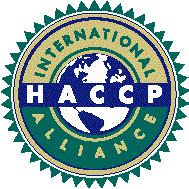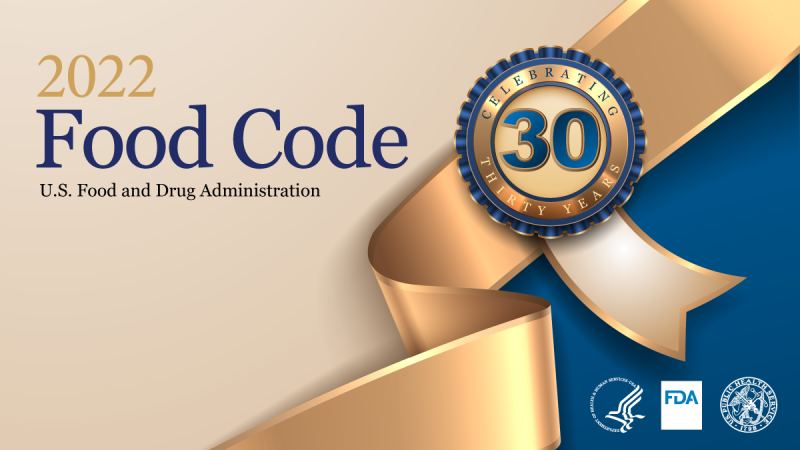The FDA New Era of Smarter Food Safety has four core components: 1. Tech-enabled Traceability 2. Smarter Tools and Approaches for Prevention and Outbreak Response 3. New Business Models and Retail Modernization 4. Food Safety Culture. The FDA Food Code 2022 defines Food Establishments as an operation that (a) stores, prepares, packages, serves, vends FOOD directly to the CONSUMER, or otherwise provides FOOD for human consumption such as a restaurant; satellite or catered feeding location; catering operation if the operation provides FOOD directly to a CONSUMER or to a conveyance used to transport people; market; vending location; conveyance used to transport people; institution; or FOOD bank; and (b) relinquishes possession of FOOD to a CONSUMER directly, or indirectly through a delivery service such as home delivery of grocery orders or restaurant takeout orders, or delivery service that is provided by common carriers. This International HACCP Alliance accredited course is designed to assist the last line of defense in the food supply chain, retail and food service industry, to prevent, eliminate or reduce food safety hazards using HACCP, FSMA, the FDA New of Smarter Food Safety and other current scientific, technical and regulatory understanding of good retail and food service practices.

On Zoom
Other dates and times can be arranged on Zoom
2024
August 1, 2024, 8:00 AM to 4:00 PM – EST
August 2, 2024, 8:00 AM to 4:00 PM – EST
October 7, 2024, 8:00 AM to 4:00 PM – PST
October 8, 2024, 8:00 AM to 4:00 PM – PST
2025 Classes
February 12, 13, 2025 – EST
June 12, 13, 2025 – PST
July 23, 24, 2025 – EST
October 29, 30, 2025 – PST
Table of Contents
Module 1. Introduction, History, Definitions
Module 2. The FDA Food Code 2022
Module 3. Applying HACCP Principles to Retail and Food Service using Process Approach – Annex 4 and the FDA Operator Manual
Module 4. Retail and Food Service HACCP – Annex 4
Module 5. HACCP Inspection by Regulatory Authorities – Annex 5
Module 6. Food Processing in Retail and the Food Code (Annex 6) – Reduced Oxygen Packaging (ROP)
Module 7. Smoking, Curing and Clostridium botulinum in Food Retail Establishments (Variance)
Module 8. The FDA Retail Program Standards
Module 9. The FDA New Era of Smarter Food Safety, Traceability and Retail Modernization
Module 10. Food Safety Hazards
Module 11. Prerequisite Programs
Module 12. Preliminary Steps
Module 13. Conduct a Hazard Analysis – The First Principle of HACCP
Module 14. Determine Critical Control Points – The Second Principle of HACCP
Module 15- Establish Critical Limits – The Third Principle of HACCP
Module 16. Establish Monitoring Procedures – The Fourth Principle of HACCP
Module 17. Establish Corrective Action Procedures- The Fifth Principle of HACCP
Module 18. Establish Verification Procedures – The Sixth Principle of HACCP
Module 19. Establish Record-Keeping and Documentation Procedures – The Seventh Principle of HACCP
Module 20. The Implementation, Maintenance and Reassessment of the HACCP Plans and Systems

Self-Paced
To be completed in 60 Days.
Table of Contents
Module 1. Introduction, History, Definitions
Module 2. The FDA Food Code 2022
Module 3. Applying HACCP Principles to Retail and Food Service using Process Approach – Annex 4 and the FDA Operator Manual
Module 4. Retail and Food Service HACCP – Annex 4
Module 5. HACCP Inspection by Regulatory Authorities – Annex 5
Module 6. Food Processing in Retail and the Food Code (Annex 6) – Reduced Oxygen Packaging (ROP)
Module 7. Smoking, Curing and Clostridium botulinum in Food Retail Establishments (Variance)
Module 8. The FDA Retail Program Standards
Module 9. The FDA New Era of Smarter Food Safety, Traceability and Retail Modernization
Module 10. Food Safety Hazards
Module 11. Prerequisite Programs
Module 12. Preliminary Steps
Module 13. Conduct a Hazard Analysis – The First Principle of HACCP
Module 14. Determine Critical Control Points – The Second Principle of HACCP
Module 15- Establish Critical Limits – The Third Principle of HACCP
Module 16. Establish Monitoring Procedures – The Fourth Principle of HACCP
Module 17. Establish Corrective Action Procedures- The Fifth Principle of HACCP
Module 18. Establish Verification Procedures – The Sixth Principle of HACCP
Module 19. Establish Record-Keeping and Documentation Procedures – The Seventh Principle of HACCP
Module 20. The Implementation, Maintenance and Reassessment of the HACCP Plans and Systems

On site:
125 Pacific Coast Highway,
Hermosa Beach, CA 90254
or your site
Table of Contents
Module 1. Introduction, History, Definitions
Module 2. The FDA Food Code 2022
Module 3. Applying HACCP Principles to Retail and Food Service using Process Approach – Annex 4 and the FDA Operator Manual
Module 4. Retail and Food Service HACCP – Annex 4
Module 5. HACCP Inspection by Regulatory Authorities – Annex 5
Module 6. Food Processing in Retail and the Food Code (Annex 6) – Reduced Oxygen Packaging (ROP)
Module 7. Smoking, Curing and Clostridium botulinum in Food Retail Establishments (Variance)
Module 8. The FDA Retail Program Standards
Module 9. The FDA New Era of Smarter Food Safety, Traceability and Retail Modernization
Module 10. Food Safety Hazards
Module 11. Prerequisite Programs
Module 12. Preliminary Steps
Module 13. Conduct a Hazard Analysis – The First Principle of HACCP
Module 14. Determine Critical Control Points – The Second Principle of HACCP
Module 15- Establish Critical Limits – The Third Principle of HACCP
Module 16. Establish Monitoring Procedures – The Fourth Principle of HACCP
Module 17. Establish Corrective Action Procedures- The Fifth Principle of HACCP
Module 18. Establish Verification Procedures – The Sixth Principle of HACCP
Module 19. Establish Record-Keeping and Documentation Procedures – The Seventh Principle of HACCP
Module 20. The Implementation, Maintenance and Reassessment of the HACCP Plans and Systems
Contact Alex to arrange the date and time:
Phone: 310-694-1544 – Email: alexkashef@geosda.com


